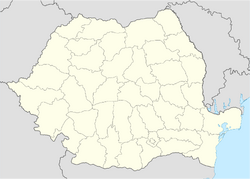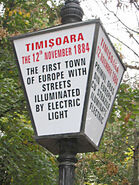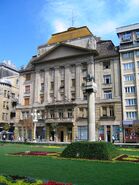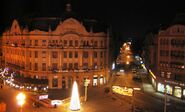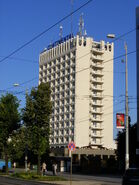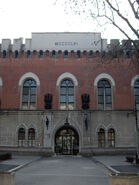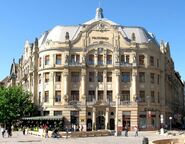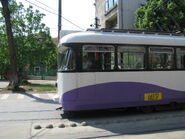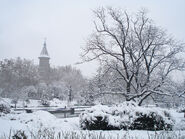| Main | Births etc |
|---|
| Timișoara | |||
|---|---|---|---|
| — City — | |||
| Victory Square | |||
|
|||
| Coordinates: Coordinates: | |||
| Country | |||
| County | Timiş County | ||
| Status | County Capital | ||
| Government | |||
| • Mayor | Gheorghe Ciuhandu (CDNPP) | ||
| Area | |||
| • City | 129.2 km2 (49.9 sq mi) | ||
| • Metro | 1,070.4 km2 (413.3 sq mi) | ||
| Elevation | 90 m (300 ft) | ||
| Population (est. 2009)[1] | |||
| • City | 312,113 | ||
| • Density | 2,400/km2 (6,300/sq mi) | ||
| • Metro | 359,132 | ||
| Time zone | EET (UTC+2) | ||
| • Summer (DST) | EEST (UTC+3) | ||
| Mailbox Code | 300030 | ||
| Tel. Code | 02 56 | ||
| Vehicle registration | TM | ||
| Website | primariatm.ro | ||
Timișoara (German: Temeschburg, also Temeswar or Temeschwar, Hungarian: Temesvár, Serbian: Темишвар/Temišvar, Turkish: Temeşvar), is a city in the Banat region of western Romania. It is the capital of Timiș County.[2]
Geography[]
Timișoara lies at an altitude of 95 m on the southeast edge of the Banat plain, part of the great Transilvania plain. The rich black soil and relatively low water table make this a fertile agricultural region.
Due to the hydrography projects undertaken in the 18th century, the city no longer lies on the river Timiş, but on the Bega canal. This is a relatively active seismic area, and earthquakes up to 6 on the Richter scale have been recorded.
History[]
Timișoara was first mentioned as a place in either 1212 or 1266. The territory later to be known as Banat was conquered and annexed by the Kingdom of Hungary in 1030. Timișoara grew considerably during the reign of Charles I, who, upon his visit here in 1307, ordered the construction of a royal palace. Timișoara's importance also grew thanks to its strategic location, which facilitated control over the Banat plain. John Hunyadi established a permanent military encampment here, and moved here together with his family. In 1552, Ahmed Pasha conquered the city with a 16,000 Ottomans and transformed it into a capital city in the region. The local military commander, Stefan Losonczy, was captured and beheaded on July 27, 1552 after resisting the Ottoman invasion with just over 2,300 men.
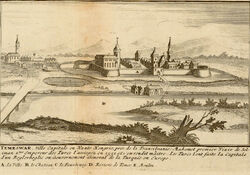
Timișoara 1656 Nicolas Sanson map
Timișoara remained under Ottoman rule for nearly 160 years, controlled directly by the Sultan and enjoying a special status, similar to other cities in the region such as Budapest and Belgrade. During this period, Timișoara underwent a process of Islamization, until Prince Eugene of Savoy conquered it in 1716. Subsequently, the city came under Austrian rule, and it remained so until the early 20th century except Ottoman occupation between 1788-1789 during Ottoman-Hapsburg war. During this time, Timișoara evolved from a strategic fortress to an economic and industrial center: numerous factories were built, electric illumination and public transport were introduced, and railroad connections were established. The city was defortified, and several major road arteries were built to connect the suburbs with the city center, paving the way for further expansion of the city limits.
It was the first mainland European city to be lit by electric street lamps in 1884.[3] It was also the second European and the first city in what is now Romania with horse drawn trams in 1867. Gustave Eiffel, the creator of the Eiffel Tower in Paris, built one of Timișoara's footbridges over the Bega.
On October 31, 1918, local military and political elites establish the "Banat National Council", together with representatives of the region's main ethnic groups: Hungarians, Romanians, Serbs and Germans. In the aftermath of World War I, the Banat region was divided between the Kingdom of Romania and the Kingdom of Serbs, Croats and Slovenes, and Timişoara came under Romanian administration after Serbian occupation between 1918-1919. In 1920, King Ferdinand I awarded Timişoara the status of a University Center, and the interwar years saw continuous economic and cultural development. A number of anti-fascist and anti-revisionist demonstrations also took place during this time.
During World War II, Timișoara suffered damage from both Allied and Axis bombing raids, especially during the second half of 1944. On August 23, 1944, Romania, which until then was a member of the Axis, declared war on Nazi Germany and joined the Allies. Surprised, the local Wehrmacht garrison surrendered without a fight, and German and Hungarian troops attempted to take the city by force throughout September, without success.
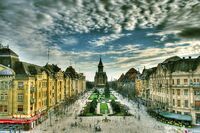
Center of Timișoara
After the war, the People's Republic of Romania was proclaimed, and Timișoara underwent Sovietization and later, systematization. The city's population tripled between 1948 and 1992. In December 1989, Timișoara witnessed a series of mass street protests by Romanians, Hungarians and Serbs, in what was to become the Romanian Revolution of 1989.
Demographics[]
For 2009,[1] Timişoara has an estimated population of 312,113, the fourth largest in Romania after Bucharest, Iaşi, and Cluj-Napoca. 14.2% of the population are under 15 years of age, 4.0% are over 75. The Timişoara metropolitan area has a population of 365,545.
The ethnic makeup, as of 2009, is as follows: 85.52% Romanian, 7.5% Hungarian, 2.25% German, 4.73% other. The Ukrainian community is currently growing, partly due to the presence of Ukrainian language educational facilities. In recent years, local investment by Italian companies has spurred the creation of an Italian community,[4] even leading to calls for an Italian Cultural Center.[5]
Since 1990, Timișoara saw a slight population decline due to migration and a drop in birthrates. Notably, the Hungarian and German communities experienced significant decline, with the latter being reduced by half between 1992 and 2002.[6]
Economy[]
Timișoara has been an important economic center since the 18th century when the Habsburg administration was installed. Due to Austrian colonization, ethnic and religious diversity and innovative laws, the economy began to develop. The technicians and craftsmen that settled in the city established guilds and helped develop the city's economy. Notably, in 1717, Temesvar became host to the region's first beer factory.
During the Industrial Revolution, numerous modern innovations were introduced. It was the first city in the monarchy with street illumination, and the first city on mainland Europe illuminated by electric light. The Bega river was also channelled during this time. It was the first navigable canal on current Romanian territory. This way, Timișoara had contact with Europe, and even with the rest of the world through the Black Sea, leading to the local development of commercialism.[7][8][9]
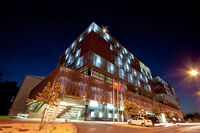
CBC Timișoara
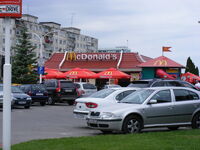
One of the two McDonald's in the city. This one is in front of the county hospital
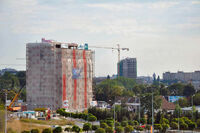
New constructions in Timișoara(Fructus Tower)
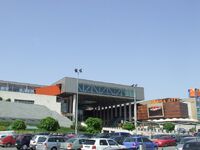
Iulius Mall Timișoara
In the 19th century, the railway system of the Hungarian Kingdom reached Temesvar. Timișoara was the first city in the country with international routes economic boom as the amount of foreign investment, especially in high-tech sectors, has risen.[10] In terms of living standards, Timișoara ranks fourth nationwide.[11] In an article in late 2005, French magazine L'Expansion called Timișoara Romania's economic showcase,[12] and referred to the increased number of foreign investments as a "second revolution".
Apart from domestic local investment, there has been significant foreign investment from the European Union, particularly from Germany and Italy. Continental AG has produced tires since opening a plant in 2000.[13] The Linde Group produces technical gases, and a part of the wiring moulds for BMW and Audi vehicles are produced by the company Dräxlmaier Group locally. Also, Swiss company FM Logistic, already present in Timiş County for Nestlé, P&G and in Bucharest for Cora, L'Oréal, Sanofi Aventis and Yves Rocher, and for companies like PROFI Rom Foods, BIC, Kraft Foods or SCA Packaging - offering them domestic transport services and international transport services for Bricostore, Arctic, Danone, Unilever or Contitech, the growth of FM Logistic in Romania and in Dudeşti through its 1st own warehouse in Romania (Dudeştii Noi gives FM the opportunity). Nestlé produces waffles here.
The USA company Flextronics maintains a workplace in the west of the city for the production of mobile telephony and government inspection department devices. In 2009, the company laid off 640 workers.[14] The American company Procter & Gamble manufactures washing and cleaning agents in Timişoara. Smithfield Foods - the world's largest pork processor and hog producer - has two subsidiaries in Timișoara and Timiș County: Smithfield Ferme and Smithfield Prod.
Like most of Romania, Timișoara experienced economic slowdown in 2009, due to the global economic downturn.[15]
Transport[]
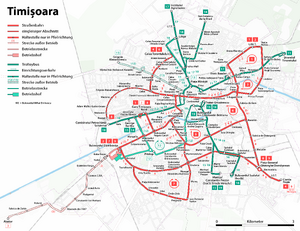
Tramway and trolleybus routes
Timișoara's public transport network consists of 10 tram lines, 8 trolleybus lines and 20 bus lines, of which 5 are metropolitan lines and 6 are express lines. It is operated by Regia Autonomă de Transport Timișoara (RATT), an autonomous corporation of the City Hall. The city is served by Romania's third busiest airport, Traian Vuia International Airport, which is the hub of the Romania's second-largest airline, Carpatair. The city is connected to a series of major European and domestic destinations. Timişoara is a major railway centre and is connected to all other major Romanian cities, as well as local destinations, through the national CFR network.
Cityscape[]
The tallest building, when completed in 2011, will be the Tender Financial Center, at 180 meters tall. The tallest building currently is the Fructus Tower, at 65 meters. Another proposed building, the Timișoara High Tower, when completed, will have a height of 138 meters, but it is not scheduled to open until 2012.
Climate[]
| Climate data for Timişoara, Romania | |||||||||||||
|---|---|---|---|---|---|---|---|---|---|---|---|---|---|
| Month | Jan | Feb | Mar | Apr | May | Jun | Jul | Aug | Sep | Oct | Nov | Dec | Year |
| Record high °C (°F) | 17.4 (63.3) |
20.5 (68.9) |
28.2 (82.8) |
32.0 (89.6) |
34.5 (94.1) |
38.4 (101.1) |
40.1 (104.2) |
41.0 (105.8) |
39.7 (103.5) |
33.8 (92.8) |
27.1 (80.8) |
20.2 (68.4) |
41.0 (105.8) |
| Average high °C (°F) | 2 (36) |
5 (41) |
11 (52) |
18 (64) |
23 (73) |
26 (79) |
28 (82) |
28 (82) |
25 (77) |
18 (64) |
11 (52) |
4 (39) |
17 (63) |
| Daily mean °C (°F) | −1 (30) |
1 (34) |
5 (41) |
11 (52) |
16 (61) |
19 (66) |
21 (70) |
21 (70) |
18 (64) |
12 (54) |
6 (43) |
1 (34) |
11 (52) |
| Average low °C (°F) | −5 (23) |
−3 (27) |
0 (32) |
5 (41) |
10 (50) |
13 (55) |
15 (59) |
14 (57) |
11 (52) |
6 (43) |
2 (36) |
−1 (30) |
5 (41) |
| Record low °C (°F) | −35.3 (−31.5) |
−29.2 (−20.6) |
−20 (−4.0) |
−5.2 (22.6) |
−5 (23.0) |
2.2 (36.0) |
5.9 (42.6) |
5.0 (41.0) |
−1.9 (28.6) |
−6.8 (19.8) |
−15.4 (4.3) |
−24.8 (−12.6) |
−35.3 (−31.5) |
| Precipitation mm (inches) | 47 (1.85) |
44 (1.73) |
46 (1.81) |
56 (2.2) |
71 (2.8) |
91 (3.58) |
67 (2.64) |
53 (2.09) |
51 (2.01) |
46 (1.81) |
57 (2.24) |
59 (2.32) |
688 (27.09) |
| Avg. precipitation days | 12 | 10 | 8 | 7 | 12 | 15 | 11 | 10 | 10 | 9 | 11 | 11 | 145 |
| Avg. rainy days | 2 | 3 | 5 | 7 | 10 | 14 | 11 | 10 | 10 | 8 | 6 | 4 | 90 |
| Avg. snowy days | 10 | 8.5 | 3 | 0.1 | 0 | 0 | 0 | 0 | 0 | 0.1 | 3 | 7.3 | 32 |
| % humidity | 91 | 87 | 81 | 80 | 77 | 79 | 74 | 75 | 76 | 85 | 92 | 89 | 82 |
| Mean monthly sunshine hours | 62 | 85 | 155 | 180 | 210 | 240 | 280 | 279 | 210 | 155 | 85 | 60 | 2,001 |
- Highest Recorded Temperature: 41.0 °C (105.8 °F)
- Lowest Recorded Temperature: -35.3 °C (-31.5 °F)
- Warmest Month: July
- Coolest Month: January
- Highest Precipitation: June: 91.0 mm(3.189 in)
- Lowest Precipitation: February: 44.5 mm(1.437 in)
The climate which defines Timișoara city is the temperate continental moderate climate which characterizes the Southern-Eastern part of The Pannonian Basin. The temperate continental climate has some submediteranean characteristics as well of the Adriatic climate.
Climatic general features consist of various and irregular weather conditions. The dominating temperate air masses during spring and summer are of oceanic origin and come with great precipitations. Frequently, even during winter period, the Atlantic humid air masses bring rainy and snowy weather, rarely cold weather.
From September until February, frequent continental polar air masses coming from East invade the area. In spite of all that, the Banat climate is also influenced by the presence of cyclones and warm air masses which come from the Adriatic Sea and the Mediterranean Sea. Their characteristic feature is that of complete snow thaw during the winter period and stifling heat during the summer period.
Neighborhoods[]
- Listed alphabetically
|
|
|
Culture[]
The city center largely consists of buildings from the Austro-Hungarian era. The old city consists of several historic areas. These are: Cetate (Belváros in Hungarian, Innere Stadt in German), Iosefin (Józsefváros, Josephstadt), Elisabetin (Erzsébetváros, Elisabethstadt), Fabric (Gyárváros, Fabrikstadt). Numerous bars, clubs and restaurants have opened in the old Baroque square (Unirii Square).
Landmarks include:
- Timișoara Orthodox Cathedral
- St. George's Cathedral (The Dome)
- Millennium Church
- Huniade Castle
Performing arts[]
- Banatul Philharmonic of Timișoara (Filarmonica Banatul Timișoara)
- Romanian Opera House (Opera Romana Timișoara)[16]
- National Theatre (Teatrul Naţional)
- German State Theatre (Teatrul German de Stat)
- Hungarian State Theatre (Teatrul Maghiar de Stat)
- Puppet Theatre (Teatrul pentru copii si tineret "Merlin")
- Festivalul Plai, a world music and jazz festival
Education[]
Timișoara has four public universities and three private universities:
Public
- West University[17]
- Polytechnic University[18]
- "Victor Babeș" University of Medicine and Pharmacy[19]
- Banat's University of Agricultural Sciences[20]
Private
- Dimitrie Cantemir University[21]
- Tibiscus University[22]
- Mihai Eminescu University[23]
Sport[]
Association football[]
- FC Politehnica Timișoara
- CFR Timișoara
Historic
- Chinezul Timișoara - 6 titles
- Ripensia Timișoara - 4 titles
- UM Timișoara
Basketball[]
- BC Elba Timișoara (M)
- CSȘ Bega Timișoara (W)
Rugby union[]
- RCM Universitatea de Vest Timișoara
Handball[]
- CSU Politehnica Timișoara
Twin towns — sister cities[]
Timişoara has 15 twin towns and sister cities, as listed below:
|
|
Natives[]
- Iolanda Balaș — athlete; two time Olympic champion in the women's high jump
- Mircea Baniciu — musician and composer, Transsylvania Phoenix and Pasărea Colibri
- Ana Blandiana — poet, essayist, and political figure
- Horia Colibășanu — the first Romanian mountain climber to reach the summit of K2, Manaslu, Dhaulagiri and Annapurna
- Cosmin Contra — footballer, voted 2 times in 1999 and 2001 the best right defender in the UEFA Team of the Year
- Hanno Höfer — German-Romanian movie director, producer and musician
- Ioan Holender —Romanian-born Austrian director of Vienna State Opera
- Hugo Jan Huss — orchestra conductor and music director
- Ion Ivanovici — military band leader and composer, best remembered today for his waltz "Waves of the Danube"
- George Lusztig — Romanian American mathematician and professor at the Massachusetts Institute of Technology (MIT)
- Zoltán Meskó — a Romanian-born American football punter for the New England Patriots
- Dan Nicolae Potra — artistic gymnast; Romania's first male gymnast to win the European all around title (2002)
- Sandra Romain — pornographic actress
- Andrei Silard — engineer and author, correspondent member of the Romanian Academy
- Cornel Trăilescu — opera composer and conductor
- Dorin Tudoran — poet, essayist, journalist, and dissident
- Andrei Ujica — screenwriter and director
- Timotei Ursu — film director, television director, writer and journalist
- Johnny Weissmuller — Romanian born American swimmer and actor of German descent, famous for winning 5 Olympic gold medals for the United States and for portraying Tarzan in films
Gallery[]
See also[]
References/Notes[]
- ^ a b "Largest cities in Romania" (in Romanian). Agerpres. February 2, 2010. http://www.agerpres.ro/english/index.php/component/k2/item/173.html. Retrieved June 13, 2010.
- ^ One of the largest Romanian cities, with an estimated population of 312,113 inhabitants (the third most populous city in Romania), Timişoara is the main economic and cultural center in Banat, in the western part of the country.
- ^ Ilieșiu 2006, op. cit. p. 330
- ^ "Timişoara, mina de aur pentru investitorii italieni". 9am.ro. http://www.9am.ro/stiri-revista-presei/Business/942/Timisoara-mina-de-aur-pentru-investitorii-italieni.html. Retrieved 2010-06-18.
- ^ QCT Connect (1992-08-19). ""Timişoara este floarea de la butonieră a relaţiilor româno-italiene" | Primaria Timişoara | Secţiuni suplimentare | Cooperare internaţională şi dezvoltare economică". Primariatimisoara.ro. http://www.primariatimisoara.ro/monitorul/index.php?meniuId=2&viewCat=23&viewItem=1503. Retrieved 2010-06-18.
- ^ "Centrul de resurse pentru diversitate etnoculturală". Edrc.ro. 2010-05-30. http://www.edrc.ro/recensamant.jsp?regiune_id=1832&judet_id=2057&localitate_id=2058. Retrieved 2010-06-18.
- ^ "Timişoara, monografie Istorică", dr.Nicolae Ilieşu
- ^ "Agenda". Agenda.ro. http://www.agenda.ro/2002/49-02-c.htm. Retrieved 2010-06-18.
- ^ "Agenda". Agenda.ro. http://www.agenda.ro/2003/44-03-a.htm. Retrieved 2010-06-18.
- ^ "La Timișoara, e vremea boom-ului economic". Wall-street.ro. http://www.wall-street.ro/articol/Economie/6132/La-Timisoara-e-vremea-boom-ului-economic.html. Retrieved 2010-06-18.
- ^ Scris de Lucian Paulescu. "Timişoara, desemnat al patrulea oraş din România ca standard de viaţă - Ziua de Vest". Ziuadevest.ro. http://www.ziuadevest.ro/actualitate/6133-timioara-desemnat-al-patrulea-ora-din-romania-ca-standard-de-via.html. Retrieved 2010-06-18.
- ^ "Timişoara Romania's economic showcase". Lexpansion.com. http://www.lexpansion.com/art/6.0.133980.0.html. Retrieved 2010-06-18.
- ^ http://www.conti-online.com/generator/www/uk/en/continental/automobile/themes/about_continental/history/1997_2006_en.html
- ^ http://www.evertiq.com/news/14398
- ^ "Economie: Economia timiseana a traversat un an destul de greu in 2009". Timisoreni.ro. http://www.timisoreni.ro/info/economie/economia_timiseana_a_traversat_un_an_destul_de_greu_in_2009.html. Retrieved 2010-06-18.
- ^ "Romanian Opera House". ort.ro. http://www.ort.ro/. Retrieved 2010-06-18.
- ^ "The West University of Timişoara". Uvt.ro. http://www.uvt.ro/. Retrieved 2010-06-18.
- ^ "The Politehnica University of Timişoara". Upt.ro. http://www.upt.ro/. Retrieved 2010-06-18.
- ^ "Victor Babeş University of Medicine and Pharmacy, Timişoara". Umft.ro. 2009-08-29. http://www.umft.ro/. Retrieved 2010-06-18.
- ^ "The Banat's University of Agricultural Sciences in Timişoara". Usab-tm.ro. http://www.usab-tm.ro/. Retrieved 2010-06-18.
- ^ "The Dimitrie Cantemir University of Timişoara". Ucdctm.ro. http://www.ucdctm.ro/. Retrieved 2010-06-18.
- ^ "The Tibiscus University of Timişoara". Tibiscus.ro. http://www.tibiscus.ro/. Retrieved 2010-06-18.
- ^ [www.umet.ro "Mihai Eminescu University of Timişoara"]. Umet.ro. www.umet.ro. Retrieved 2011-03-10.
External links[]
- People from Timişoara
- An introduction to Timişoara by Prof. Harry W. Morgan
- Timişoara's home page, the oldest Romanian page on the net
- City of Timişoara Homepage
- Timişoara Tourism
- Tourist Bureau of Romania
- Updated map of Timişoara
| |||||

|
Dumbrăvița | Ghiroda | 
| |
 Timișoara | ||||
| Giroc | Moșnița Nouă |
| This page uses content from the English language Wikipedia. The original content was at Timișoara. The list of authors can be seen in the page history. As with this Familypedia wiki, the content of Wikipedia is available under the Creative Commons License. |


